January 4, 2019
Air Date: January 4, 2019
FULL SHOW
SEGMENTS

A Greener U.S. Congress
View the page for this story
In the 116th United States Congress seated January 3, 2019, Democrats now hold a majority in the House of Representatives for the first time in nearly a decade. Under Speaker Nancy Pelosi the House leadership now recognizes the science of climate change and has created a new Select Committee on the Climate Crisis. Senior Vice President of Governmental Affairs for the League of Conservation Voters, Tiernan Sittenfeld, joins host Steve Curwood to discuss this new environmental majority in the House and related incoming committee chairs. (10:31)
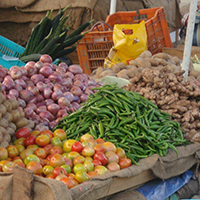
Kerala’s Ambitious Organic Pledge
/ Helen PalmerView the page for this story
Rising rates of cancer in the tropical south Indian state of Kerala have alarmed doctors and the public, and many blamed high levels of chemicals in food. So the government is working to make Kerala’s food supply all-organic by 2020. Living on Earth’s Helen Palmer takes a trip to Kerala to discover what’s involved. (17:32)

Pesticide Peril in Paradise
/ Helen PalmerView the page for this story
We continue our coverage of Kerala, India’s efforts to reduce pesticide use to take a look at how its ambitious target can be achieved. Part of the success will depend on middle class Keralans who have taken up organic gardening as a hobby, or even a second career. They tend to their rooftop gardens, care for their backyard livestock, and sell extra produce at large organic markets where their chemical-free food sells for premium prices. Living on Earth’s Helen Palmer has the story. (18:22)
Show Credits and Funders
Show Transcript
HOSTS: Steve Curwood
GUESTS: Tiernan Sittenfeld
REPORTERS: Helen Palmer
[THEME]
CURWOOD: From Public Radio International – this is Living On Earth.
[THEME]
CURWOOD: I’m Steve Curwood.
With a New Year and a new Congress, Democrats now control the House and while climate skeptics still rule the Republican Senate and White House, green activists say Dem House Committee chairs will change the game.
SITTENFELD: I feel so relieved and so excited that we now have a pro-environment majority in the House of Representatives after years of doing battle with the most anti-environmental House of Representatives ever.
CURWOOD: With high rates of cancer in Kerala, India, people are turning to organic agriculture, and urban gardeners are leading the way.
MANU: We decided to call all our family here and we made food out of what we’d grown from our terrace. We’ll have boiled rice, and there would be a curry that is called a sambah, so it would be a complete vegetarian feast.
CURWOOD: That and more this week on Living on Earth – Stick Around!
[NEWSBREAK MUSIC: Boards Of Canada “Zoetrope” from “In A Beautiful Place Out In The Country” (Warp Records 2000)]
[THEME]
A Greener U.S. Congress

Incoming Speaker Nancy Pelosi takes the oath of office surrounded by children of Members in the House Chamber at the start of the 116th Congress. (Photo: Phil Nguyen, House of Representatives)
CURWOOD: From PRI and the Jennifer and Ted Stanley Studios at the University of Massachusetts Boston, this is Living on Earth. I’m Steve Curwood.
Congressional Democrats now hold the House majority for the first time in almost a decade and that will make a difference for environmental affairs. For starters, Speaker Nancy Pelosi of California has rebooted the old House Select Committee on Energy Independence and Global Warming into a new House Select Committee on the Climate Crisis. The Climate Crisis panel doesn’t have subpoena powers, or the ability to advance legislation to the House floor. But speaker Pelosi declared “this committee will be critical to the entire Congress’s mission to respond to the urgency of this threat, while creating the good-paying, green jobs of the future.”
The speaker named six-term Florida Congresswoman Kathy Castor as Climate Crisis chair. She represents the low-lying Tampa area which narrowly avoided catastrophe in October of 2018 during Hurricane Michael. Ms. Castor co-chaired a Democratic House report in May of 2018 about what it called “Trump’s Toxic Team” of environmental officials, detailing allegations of corruption, self-dealing and abuse of taxpayer money at the expense of public health and safety. And of her new role Kathy Castor says, “The Select Committee on the Climate Crisis and the new generation of leaders in Congress -- who understand the scientific imperative -- will tackle the crisis head on. Failure is not an option.”
For insights on some standing committee chairs we called up the Senior Vice President of Governmental Affairs for the League of Conservation Voters, Tiernan Sittenfeld.
Welcome to Living on Earth!
SITTENFELD: Hi, thanks so much for having me.
CURWOOD: So big change up there on the House in terms of folks who are now coming into power, who are concerned about environmental protection, huh?
SITTENFELD: Very big change. We are absolutely thrilled to have a pro-environment majority in the House of Representatives and eager to get to work.
CURWOOD: Now, when you say you have a pro-environment majority, you base that on what?
SITTENFELD: So we base it on the enthusiasm and the energy and the expertise of the new members, combined with the returning members. We have a bunch of new members of Congress, who many of them ran on protecting the environment, on fighting the climate crisis. And in fact, 56 of the 62 new members of the House of Representatives supported 100% clean energy by 2050 on the campaign trail.

Rep. Kathy Castor(D-FL) has been named the Chair of the House Select Committee on the Climate Crisis, previously known as the House Select Committee on Energy Independence and Global Warming when Speaker Pelosi established it in 2007. (Photo: United States Government, Wikimedia Commons, Public Domain)
CURWOOD: So here we are, it's a new year and a new Democratic majority in the House of Representatives for the 116th Congress. So one of the things about being in the majority is that now the senior members of the various committees chair them, and they have all kinds of power from subpoena to holding hearings. So let's talk about some of these new chairs for the committees that are connected to the environment. Frank Pallone, Jr. of New Jersey, will be chairing Energy and Commerce. What do you expect his priorities will be?
SITTENFELD: Frank Pallone is a long time environmentalist, he has a 96% lifetime score on LCV's National Environmental scorecard and we know that he cares deeply about fighting for clean air and clean water, and especially for fighting climate change. And he made clear already after the elections once it was clear that he would be the incoming Chair of the Energy and Commerce Committee that he wanted to take early and significant action on climate change. So we're really looking forward to working with him and his staff.
CURWOOD: Now, what do you suppose he will do in terms of his ability to call parts of the administration up to the Hill and ask questions?
SITTENFELD: I expect him to be very tough when it comes to investigating just how much the Trump administration has been in bed with their polluter allies, and we have seen the devastating impacts of climate change as they continue to try to double down on the dirty failed fossil fuel friendly policies of the past. So we expect that to be a real priority for Chairman Pallone.
CURWOOD: Now, over at the House Natural Resources Committee, Raúl Grijalva of Arizona will take over now as Chair; tell me what you expect his agenda will be there?
SITTENFELD: Congressman Grijalva is a real champion when it comes to protecting public lands and wildlife and he has a 96% lifetime score on LCV’s national environmental scorecard, which is quite impressive. He got 100% in 2017, and he's not just a good vote. He really cares when it comes to protecting our public lands, especially our national monuments. He's been a real fighter for full funding and permanent reauthorization of the Land and Water Conservation Fund. And we see there's going to be lots of oversight opportunities for looking at all of the egregious rollbacks and attacks of public lands protections over the last couple years from the Trump administration.
CURWOOD: Peter DeFazio of Oregon is the incoming Chair of Transportation and Infrastructure. Tell me what you think is on Congressman DeFazio’s agenda as he comes in as Chair?
SITTENFELD: Congressman DeFazio is a long time environmentalist. And we believe that he and the Democrats across the board for the most part are really serious about putting forward an infrastructure proposal that is going to promote clean energy. It's going to promote clean water infrastructure. We hope that it will really be a down payment on the many important needs in addressing climate change across this country. Senator Schumer actually published a great op-ed in the Washington Post in December and sent a letter to President Trump saying that infrastructure was an opportunity to work together and to get something done for the country, but only if it was an opportunity to address the climate crisis and to promote clean energy. So we're really excited about that approach.
CURWOOD: Let me ask you about the Incoming Chair now of the Science, Space and Technology committee. That's Eddie Bernice Johnson from Texas. What do you think her agenda is going to be going forward now, as chair of that committee?
SITTENFELD: We've been really excited about some of the remarks and the comments that we've seen from Eddie Bernice Johnson, which could not contrast more strongly with her predecessor more strongly with the Trump administration, which clearly denies basic science, particularly the basic science of climate change. So we think that she is going to work closely with scientists, she's going to rely on science, she's going to promote science. And that's absolutely the way it should be. And we cannot wait to get to work with her.
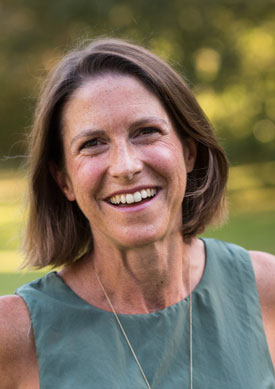
Tiernan Sittenfeld is the Senior Vice President of Governmental Affairs for the League of Conservation Voters. (Photo: Courtesy of League of Conservation Voters)
CURWOOD: In 2018, and even in 2017, we saw a number of cases where federal scientists were being harassed, intimidated, being pushed off of advisory committees and all that sort of thing. What do you think incoming Chairwoman Johnson will do about that situation, the intimidation of our federal scientists?
SITTENFELD: One of the most disgraceful aspects of the Trump administration -- and I know that's a big statement because there's so many things that are so disgraceful about this administration. But the intimidation of scientists, the gagging of scientists, the dismissing of years and years of science and research is so appalling, and it could not be more important to everything that Eddie Bernice Johnson move in a different direction, and more confident she's going to do exactly that.
CURWOOD: With these new House committee chairs and the new Democratic majority, what do you think the house will be able to achieve in the coming years in terms of environmental protection, given that the Senate still remains in Republican hands, as does the White House?
SITTENFELD: We are really excited about the opportunity for this new pro-environment majority in the House of Representatives to make progress when it comes to protecting the environment and public health and especially to combating the climate crisis. That said, as you just noted, we still have a Senate led by Mitch McConnell, who is a climate change denier, and we still have Trump in the White House. So we don't anticipate major climate legislation getting enacted into law. But the oversight opportunities are extremely important to make crystal clear for all people in this country. What is at stake for the air that they breathe, for the water that they drink, for the lands and the wildlife that they cherish. And we really need to understand in a very clear way, who is benefiting -- clearly in this case the polluters, the oil and gas companies, the coal companies -- at the expense of our health of our communities.
CURWOOD: There has been a bipartisan caucus about climate change called the Climate Solutions Caucus, how's that caucus now gonna proceed in the house, do you think?
SITTENFELD: It will be interesting to see how the bipartisan Climate Solutions Caucus proceeds in the 116th Congress, and that is partly because that caucus was basically decimated, of the 45 Republicans who were part of it, I believe 24 of them lost their seats. But we hope that those Republicans who are left and who remain in that caucus are actually sincere about addressing the climate crisis, and that they're going to want to work across the aisle to make progress. Because of course, if we look back to our bedrock environmental laws, they were passed by overwhelming bipartisan majorities and largely signed into law by a Republican president. So historically, the environment enjoys bipartisan support. I think, unfortunately, with the rise of the Koch brothers and Citizens United and Americans for Prosperity and others, that we have seen the environment become more of a partisan issue, really, because the polluter allies on the Republican side have just dragged their party so far to the right and radical direction. But we would love to have Republicans come back and work with us on common sense solutions to addressing the climate crisis. And I think we actually have seen some progress at the state level, even during the Trump administration, with state legislators and Republican governors saying, no, we're still in, we still care about climate change. Obviously, we have to act. So we'd love to see more of that in Congress as we move forward.
CURWOOD: Tiernan, let's step back for a moment and give me the big picture. How do you feel about the future of the house in terms of its ability to protect the public interest in the environment and these coming years?
SITTENFELD: I feel so relieved and so excited that we now have a pro-environment majority in the House of Representatives after years of doing battle with the most anti-environmental House of Representatives ever. And while we still have extreme Republican leadership in the Senate, and we still have Trump in the White House, the opportunity to go back on offense, whether it's doing government oversight and accountability of the Trump administration's efforts to sell out our environment and our health to polluters at every opportunity, or whether it's the opportunity to push for a climate-smart green infrastructure package or to push for 100% clean energy. I feel really optimistic and excited about the opportunity for progress over the next couple of years, with even more progress to come after the 2020 elections.
CURWOOD: Tiernan Sittenfeld is the Senior Vice President of Government Affairs for the League of Conservation Voters. Thanks for taking the time with us Tiernan.
SITTENFELD: Thank you, Steve.
Related links:
- League of Conservation Voters | “2018 Election Debrief: Climate, Environment & Clean Energy Win Nationwide”
- LCV’s National Environmental Scorecard (Interactive Map)
- Fortune | “Pelosi Names Castor Chair of New Committee to Address Climate Crisis”
- Ballotpedia | The 116th United States Congress
- CNN | “A historic day in Congress”
- Kathy Castor (D-FL) statement on chairing House Climate Crisis Committee
[MUSIC: Christian McBride and Roy Hargrove, “Baubles, Bangles And Beads (Feat. Roy Hargrove)” on Conversations With Christian, The McBride Company]
CURWOOD: Coming up – A sharp rise in cancer rates has Kerala, India looking to organic agriculture to improve public health.
ANNOUNCER: Support for Living on Earth comes from Sailors for the Sea and Oceana. Helping boaters race clean, sail green and protect the seas they love. More information at sailors for the sea dot org.
[CUTAWAY MUSIC: https://www.youtube.com/watch?v=q2ZnJiPQ3hM
Vayali Folklore Group, “Kerala” recorded live at the Sahaj Parab, 2015, published by Musiana]
Kerala’s Ambitious Organic Pledge
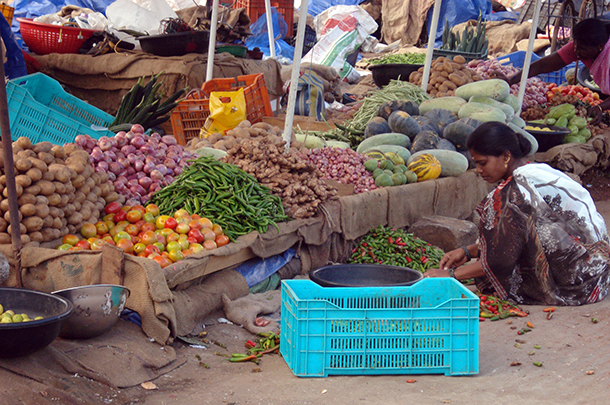
CURWOOD: It’s Living on Earth, I’m Steve Curwood.
Kerala, India could be Paradise. Tucked along the western side of the southern tip of India, the state is always warm or even hot, wet and luxuriant. Coconut palms fringe its beaches, and line its roads, crops grow year-round, and Keralans are among the best educated in the world, with a literacy rate of about 98%. Kerala grows spices including cinnamon, nutmeg, and pepper, but today its biggest export is its people, who work in businesses and bureaucracies in the Middle East and remit money back home. That cash has boosted Kerala’s financial economy, but it has also left it short of people to work the land. There is locally produced rice, but most of the food is imported and both rice and imports rely heavily on chemicals. Alarm at excess chemicals in food and rising cancer rates caused the Kerala government to pledge to go 100% organic by 2020. Living on Earth’s Helen Palmer took a trip there to check it out.
[MUSIC FROM GANESH TEMPLE IN TRIVANDRUM]
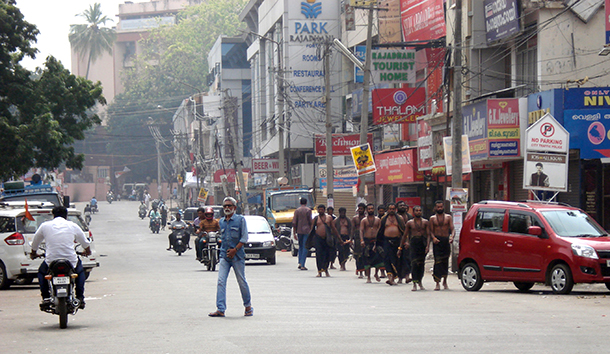
Helen Palmer visited Kerala’s capital Trivandrum during pilgrimage season. Devout Hindus travel long distances and walk barefoot in black dhothys to visit the Sri Padmanabhaswamy temple. (Photo: Helen Palmer)
PALMER: It’s pilgrimage season when I arrive in Kerala’s capital, Trivandrum. Streets are thronged with devout Hindus wearing black dhotis, the wide length of cotton cloth Indian men wear knotted round the waist. They trudge barefoot from the Central Railway station to the monumental Sri Padmanabhaswamy Temple, reputedly the richest in the world. To a visitor, it’s a reminder of the deep history and traditions still powerful in modern Kerala, which is actually dealing with a modern plague – rising rates of cancer widely blamed on pesticides and chemicals in food. Biju Prabakhar is director of Agricultural Development for Kerala.
PRABAKHAR: I was food safety commissioner of the state in 2010 to 2013, during which we have found that lots of pesticide residue are on vegetables, then antibiotics on meat and poultry. Or even some of the fish sellers or ice factory owners, they were keeping fish in formalin and ammonium sulfate and that kind of chemicals. So this was actually widely-publicized in the media, that these kinds of spurious material are in our food. And the medical community agreed this is one of main reasons for the cancer, because Kerala has a high incidence of cancer.
PALMER: In the three years up to 2016, cancer rates in Kerala rose over 10% faster than in most of the country, and two-thirds of cases prove fatal, due to a lack of specialized care. Biju Prabakhar says public anxiety, and the cancer link with pesticides in food, much of which is imported, is why there’s such urgency to become self-sufficient in local organic produce.

Pilgrims trade their black dhothys for plain white ones to enter the Vishnu Sri Padmanabhaswamy temple, reputedly the richest in the world with vaults full of gold and diamonds. (Photo: Helen Palmer)
PRABAKHAR: Now people are really aware about this and during the last three to four years the production of vegetables has almost doubled, and we are trying to reach the target of nearly around 20 lakh, 200,000 tons of this vegetables to be produced over here – we are just short of that, 100,000. So this state is poised to convert itself to – not only vegetables, coconut, everything has to be certified without chemicals.
PALMER: Rice is the main local grain, and though Kerala traditionally grows 600 varieties, most commercial paddy fields are full of high yielding, hybrid strains grown with chemicals. Export crops – spices like black pepper, turmeric, and cardamom, and commodities like rubber, coffee and coconuts – occupy a third of the state’s agricultural land, and farmers favor them over labor intensive vegetables, partly because there’s a shortage of farm labor. That’s one result of Kerala’s low birth rate related to the high level of education, which also means there are better paying jobs to choose. And the state has other hurdles to boosting food production to meet its goal of going 100 percent organic by 2020. Kerala’s rice pot is a narrow, coastal plain sandwiched between the sea and the Western Ghats, thickly forested highlands in the west.
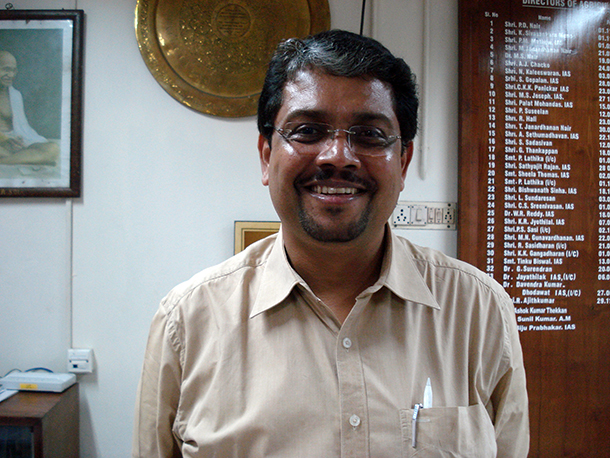
State Agricultural Development Director Biju Prabakhar is helping Kerala achieve 100% organic food by 2020. The rejection of chemicals in farming is in response to the perception that they are implicated in high rates of cancer. (Photo: Helen Palmer)
SHULAPANI: One major thing, which is needed, especially for the poor farmers, is land.
PALMER: Usha Shulapani, director of the sustainability non-profit, Thanal, says that shortage of agricultural land gets worse because fields are given as dowries when girls get married or is subdivided between the farmers’ sons – more than 92% of land holdings in the state are less than half an acre. So farms become too small to be economically viable, and since other jobs pay better, working on the land fell out of favor.
SHULAPANI: In last 10 to 20 years what is happening in Kerala is that because people were moving away from farming, most of the people who have land, they are into other occupations, so the land is lying fallow – so the people started seeing cheap land, so people with other interest come and buy.
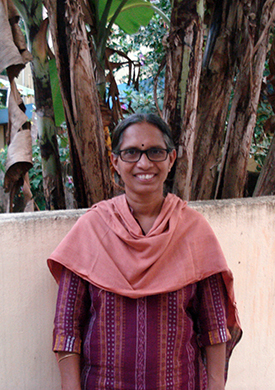
Usha Shupalani is the Executive Director of Thanal, a non-profit organization that seeks to raise awareness about sustainability and the environment. (Photo: Helen Palmer)
PALMER: This view of land as commodity has led to speculation, and urbanization, and a real estate boom that caters to Keralans returning from abroad with cash and looking for larger houses. On top of that, says Usha, there’s a problem with the agricultural leases for landless farmers – they’re too brief.
SHULAPANI: We need a policy for leasing, where the farmers, the poor farmers need to get land on a long-term basis, for five to 10 years like that, not for one year.
PALMER: With a one-year lease farmers have little incentive to improve the quality of the soil. Agriculture Director Biju Prabakhar says there’s a plan to ensure that land doesn’t lie fallow if an absentee landlord isn’t using it.
PRABAKHAR: So absentee farmers we’ll not allow not even a single land parcel to remain without cultivation. We are formulating that kind of a law which will encourage the leasing of land to other farmers, or farmer collectives or otherwise we are planning to have some kind of a taxation on those who are idling on the land. Ultimately, land is not the property of an individual, it’s the property of the state.
PALMER: Taxing or taking over fallow land is all part of the Communist State Government’s comprehensive “Green Kerala” program that covers everything from planting vegetable gardens in schools to composting food waste to create bio-gas. To help generate more income for farmers, Green Kerala mounted an ambitious “agripreneurship fair” at the former Maharajah’s Kanakakkunnu Palace, to showcase ideas to add value to everything – from coconut fiber for shoes and handbags to root vegetables. Technical Officer Safiya Shanavas of the Central Tuber Crop Research Institute points proudly to a pile of unfamiliar knobbly roots of all shapes, sizes and colors – taro, cassava, yams – and tells me there are endless ways to use them.
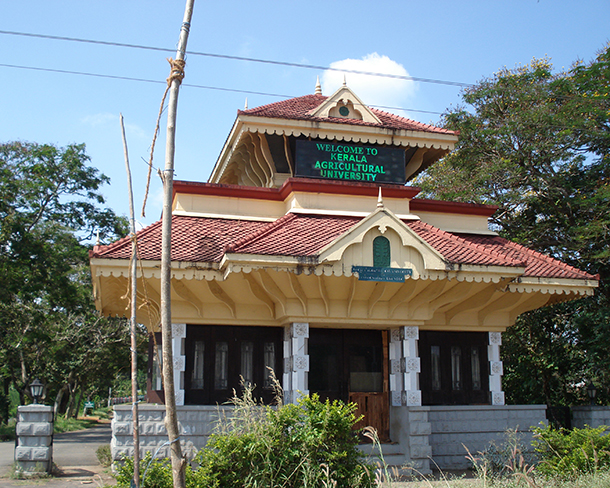
Kerala’s Agricultural University is responsible for providing the resources, skills, and technology required for the sustainable development of agriculture in Kerala. (Photo: Helen Palmer)
SHANAVAS: Whatever you can prepare with potato we can prepare with all tuber crops. Cassava chips we are having, sweet potato chips we are having, taro chips we are having, then we have noodles, then we have pasta.
PALMER: He tells me farmers can bring their crops to the Tuber Research Institute, which will use their fancy machines to turn them into jam and flour and snacks. Cassava is gluten free, Shanavas tells me, and many of these roots are loaded with antioxidants. Indeed, that’s one thing I found most striking: every food, every spice anyone grows here seems to have some special health benefits – it fights cancer, it’s good for the heart. This focus resonates with the Indian tradition of Ayurvedic medicine, and some 30 years ago Kerala opened the world’s first Ayurvedic resort. Several stands at the fair celebrate “Jack, the wonder fruit.” It’s a massive, spiky, yellowish-brown tree fruit -- very fibrous, and versatile and very good, I’m told, for fighting diabetes.
JACK FRUIT VENDOR: From the seed we make cakes and the biscuits and from the spikes we make pickles, it’s very tasty and very spicy, OK, and we can make that wine. It’s actually banned in Kerala.
PALMER: No wine in Kerala?
VENDOR: No, there is wine, but it is illegal. OK. From the pulp we can make juice, jams, squash a lot of things, halva.
PALMER: So jack fruit makes many many things?
VENDOR: Yes of course, around 3,000 products we can make it from jack fruit.
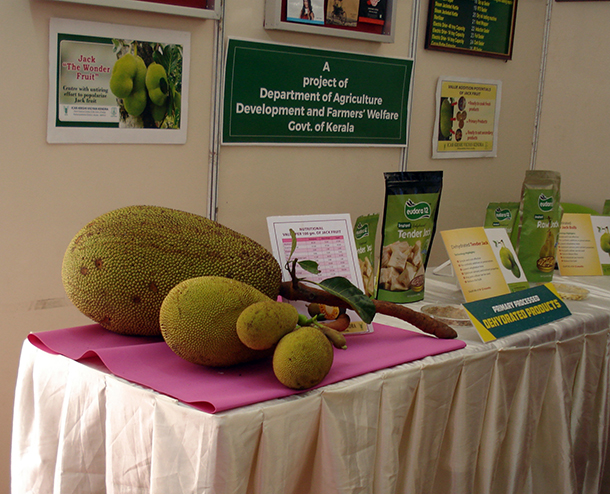
Advocates call it “Jack, the Wonder Fruit.” Jackfruit is an enormous, fibrous, versatile tree fruit that is used to make some 3,000 products, from cakes and jam to pickles and wine. (Photo: Helen Palmer)
PALMER: The palace is packed with curious Keralans keen to try free samples, and check out the displays of local fishes and biodiversity. One agriculture officer tells me it’s becoming very trendy now to be interested in growing food. But it’s no easy task to increase organic food production, and even the productivity of commercial rice is falling, partly due to problems with the soil itself.
Kerala’s earth is mostly acidic, so it needs lime. That tends to leach out with the heavy rainfall and feeding the soil properly is vital. But government subsidies don’t help the average farmer do that. Despite the ambitious long-term plans to help the switch to organic practices, the state’s yearly budgets are always squeezed. The subsidies only cover the cheapest form of nitrogen fertilizer, urea, and not the other major components of healthy soil that organic crops need, such as phosphorus and potassium. Thomas Anish Johnson is a soil survey officer who teaches at Kerala Agricultural University.
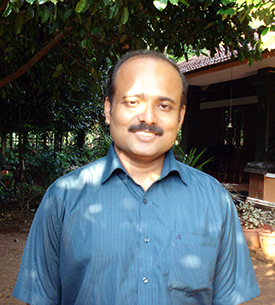
Government Soil Survey Officer Thomas Anish Johnson teaches at Kerala Agricultural University. He says crop yields are falling partly because poor farmers have difficulty improving Kerala’s acid soil and the state does not subsidize enough major nutrients. (Photo: Helen Palmer)
JOHNSON: The typical India Government subsidy is given for the major nutrients only, to the nitrogen fertilizers, that the urea is mainly subsidized and the other nutrients are being imported, so they are not given subsidy. Lime is also sometimes not given at a subsidized rate, so lime application is also not practiced mostly.
PALMER: Give me some idea of what the subsidized price for the fertilizer would be versus what has to be imported?
JOHNSON: So here the subsidized urea is given at around 5 rupees per Kg – while the other vital nutrients, that is phosphorus and potash around 20 – 25 rupees per Kg – so that is 3 to 4 times the price of the urea.
PALMER: Without a thick layer of organic mulch to retain water, urea tends to make the soil more acidic, and not adding minerals – due to the cost -- helps create micronutrient deficiencies. Lack of boron and magnesium, for example, affect crop quality and yield. Government figures show Kerala’s farmers are inefficient. More generous support could help them improve soil health, and the nutritional value of their produce, and that in turn could help public health, ultimately reducing the private and public expense of treating so many cancer cases.

There are many shrines on Trivandrum streets, and devout Hindus drape marigold garlands round those that honor Ganesha, one of the beloved Hindu deities. The elephant-headed god is known as the remover of obstacles, the patron of arts and sciences, and the ruler of intellect and wisdom. (Photo: Helen Palmer)
And the Agricultural University is dealing with another headache that plagues farmers – a bumper crop of insects. The University’s a sprawling, leafy campus outside Thrissur, the cultural capital of Kerala, that’s dedicated to improving the state’s food, farmers’ methods and pest control.
Entomology professor Berin Pathrose, trim and bald with a moustache and glasses, tells me the state’s warm tropical climate means that harmful insects – literally – have a year-round field day. He shows off a bunch of them in a large display case in the hall outside his office.
PATHROSE: This section carries the pests of fruit crops – mango, banana, guava, jack, papaya, lychee, grapes etc etc. We have a major pest called mango stem borer –
PALMER: It’s very big – about an inch and a half!
PATHROSE: Yes more than that if you consider the length of its antennae. It can bore into the heavy trunk of mangos, it will kill the mango. In the citrus we have citrus butterflies – it's a very good looking butterflies. Then coming to the next section is the plantation crops, Kerala is known for several plantation crops – where we have coconut, cashew, coffee, areca nut, rubber, ginger etc.
PALMER: To combat all these harmful insects, Professor Pathrose specializes in bio-control agents, organic methods specific to each pest. But he tells me climate change and the insects’ ability to adapt make it a constant cat and mouse game to keep up.
His plant pathologist colleague, Resmy Vijayaraghavan, a slim woman in a colorful sari, says the benefit of bio-control methods is that they not only build resistance in the plants, they help increase the harvest. Yet she doubts that Kerala can achieve its ambitious goals of totally organic food by 2020.
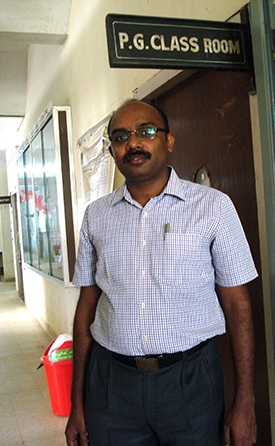
Entomology Professor Berin Pathrose specializes in bio-control agents at Kerala Agricultural University. But insects are masters at adapting to the changing tropical climate and Pathrose says it’s hard to keep pace. (Photo: Helen Palmer)
VIJAYARAGHAVAN: No actually, I wouldn’t support total organic cultivation because once the disease occurs no bio-control agents are going to be effective. So in such cases you have to resort to chemical pesticides – so the halfway organic, halfway chemical pesticides, that is the only way out. If you go for organic cultivation, the farmers might strike with a big loss.
PALMER: She argues it’s particularly the main commercial crop, rice, and spices like black pepper, nutmeg and cinnamon that need chemical treatments. But some traditional methods, such as intercropping, using locally adapted indigenous seeds and crop rotation, could help prevent infestations in the first place. Still, Kerala’s developed a whole cottage industry to make bio-control agents for the farm and home.
I drop in on the nerve center of one of the most energetic groups, headed by a cheerful determined woman in a brilliant blue and green tunic over bright green pants – who arrives on a motorbike.
[SOUND OF MOTORBIKE STOPPING]
RAJ: Helen?
PALMER: I am Helen. You are Asha Raj?
RAJ: Asha Raj.
PALMER: I am so pleased to meet you!
RAJ: Come on.
PALMER: She takes me to a Spartan, functional back room.
RAJ: I’m agricultural officer, I’m Asha Raj – my name is Asha Raj, and our Kerala government has sent me to national institute of plant health management, Hyderabad, for understanding about the various technique for on-farm production of biocontrol agents.
PALMER: Asha Raj brought that technical knowhow back from Hyderabad and now spearheads an SHG, a self-help group of women, many poor and barely educated, who make these bio-control mixtures at her office. It’s a modest, somewhat ramshackle building that doubles as a plant nursery. She says farmers might want to use fewer pesticides, but organic treatments still aren’t widely available and they cost too much, so she’s passing on what she’s learnt.
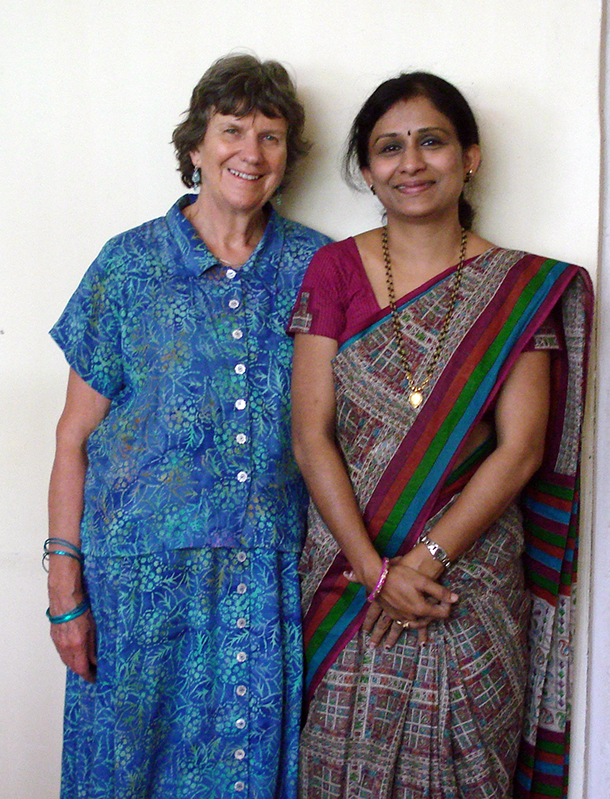
Plant pathologist Resmy Vijayaraghavan (right), with Living on Earth’s Helen Palmer (left). Vijayaraghavan says biocontrol agents are crucial to build resistance in plants and increase harvests, but chemical pesticides are still vital in cases of severe insect infestation. (Photo: Helen Palmer)
RAJ: Here we are training the farmers in such a mode that they can to produce these on-farm bio-control agents in their farm itself.
PALMER: She shows me the treatments they make – some feature concentrated cow urine, which she tells me can both kill insects and improve soil. Then there are bottles of bio-repellants with garlic and neem oil for pests like thrips, fruit fly traps powered by pheromones to protect cucumbers, jars of pseudomonas and trichloderma fungi that control soil pathogens.
RAJ: Shall we go upstairs?
[FOOTSTEPS ON STEPS]
PALMER: Oh I see all your seedlings there!
[FOOTSTEPS]
PALMER: There are rows and rows of pots of plants – rice, tomatoes, eggplants, and peppers on the terrace, and Asha Raj tells me they inoculate the roots with helpful fungi called VAM – vesicular arbuscular mycorrhiza – to produce a biofertilizer that helps plants take up nutrients.
PALMER: And these are rice are they?
RAJ: Yes it’s rice, because in the fibrous root system VAM, it’s very much good to grow.
PALMER: So basically, this is stuff that you grow and then you give to the farmers or sell to the farmers?
RAJ: Yeah, this is being produced by our SHG and it is supplied to the farmers in the whole Trivandrum district.
PALMER: Asha Raj says she’s already trained dozens of farmers and it’s paying off for them – their organic crops now sell for prices at least 50% higher than conventional ones. But making those higher prices the reality for every farmer is a steep hill to climb.
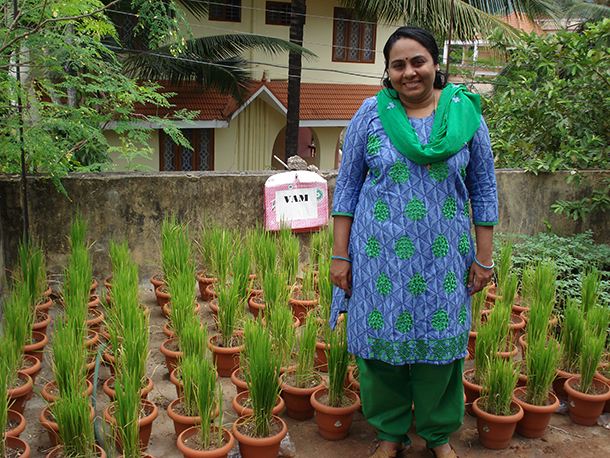
Agricultural Officer Asha Raj leads a group of women creating inexpensive homemade biocontrol agents, used to replace more toxic pesticides. (Photo: Helen Palmer)
Usha Shulapani of the non-profit Thanal says what financial help the government does offer needs to be firmly focused not on what’s being grown, but on the farmer.
SHULAPANI: Till now the whole policy was not farmer centric, it was crop-centric. Who needs to get the support is farmer, not the crop. We have to promote mix of cropping and also crop rotation for the farmers to become sustainable both economically and ecologically.
PALMER: Kerala’s Agriculture Director Biju Prabakhar is fine with supporting the farmers. But he says in the name of public health and their own health, people should be happy to pay higher prices for safe, nutritious food.
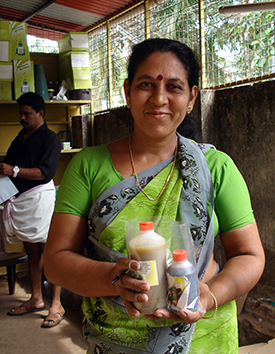
Above, one of the women Asha Raj has trained to produce bio-control agents: safer, organic and cheaper alternatives to industrial pesticides. (Photo: Helen Palmer)
PRABAKHAR: The farmers have to be subsidized, because they are the persons who are producing. The question is whether you’d like to pay more for foodstuffs, or whether you like to pay at least ten times in the hospital for treatment of some of the disease.
PALMER: And Usha Shulapani says another shift to make the organic goal a reality is reviving old indigenous varieties – they are more nutritious and can be a hedge against climate change – along with permaculture practices. I’m struck by how the solutions she says Kerala needs sound remarkably like the fixes organic enthusiasts recommend here in the US. Maybe in the end, since we have just one Earth, feeding and caring for the soil is the key to health and nutritious food for all of us, whether we pray to Vishnu or some other god.
[TEMPLE MUSIC, SINGING, PERCUSSION]
Related links:
- The Government of Kerala, India
- Kerala Agricultural University
- Thanal: People, Planet, Sustainability
CURWOOD: Coming up, Helen Palmer continues her report from Kerala to tell us about urban residents who are taking up organic gardening on small plots and terraces. Keep listening to Living on Earth.
[MUSIC: https://www.youtube.com/watch?v=O2K0ptoYpuc
Zakir Hussain & Rakesh Chaurasia / EtnoKraków / ROZSTAJE Crossroads Festival & Euroradio EBU '15]
ANNOUNCER: Funding for Living on Earth comes from you, our listeners, and United Technologies, combining passion for science with engineering to create solutions designed for sustainability in aerospace, building industries, and food refrigeration. UTC companies such as Otis, Carrier, Pratt and Whitney, and UTC Aerospace systems are helping to move the world forward. You can learn more about United Technologies by tuning into the Race to Nine Billion podcast; listen at racetoninebillion.com. This is PRI, Public Radio International.
[CUTAWAY MUSIC: https://www.youtube.com/watch?v=wWJRwz7oBb4
Zakir Hussain, Rakesh Chaurasia, Live]
Pesticide Peril in Paradise

Sujitha Sudhakaran grows dozens of vegetables on her roof terrace using her own organic compost. (Photo: Helen Palmer)
CURWOOD: It’s Living on Earth, I’m Steve Curwood.
We continue our story now about the organic goals in Kerala. In order to reach 100% organic agriculture by 2020 the government will need to re-think the way it subsidizes farmers and distributes land. But many of the Keralan people are already taking up organic gardening on their rooftops with enthusiasm and passion. Living on Earth’s Helen Palmer has our story.
[TINNY MUSIC PLAYING IN TAXI]
PALMER: To see what organic home gardening means in practice in Kerala, I took a bumpy taxi down dusty pot-holed lanes to the outskirts of the capital Trivandrum to meet Sujitha Sudhakaran…
[CAR DOOR SLAMS, TAXI IDLING, MUSIC CONTINUES]
SUDHAKARAN: Hi Helen!
PALMER: Hi Sujitha, thank you for coming to meet me!
SUDHAKARAN: Oh, it’s so nice to meet you!
PALMER: So great to meet you!
PALMER: Sujitha’s medium height and plump, with laughing black eyes and a royal blue blouse over maroon pants. She and her husband Manu live in a tidy square house set back from the road amid a riot of green – flanked by fruit trees with dozens of pots full of plants and waterlilies crowding the front courtyard ….
SUDHAKARAN: Actually I have almost 27 varieties of waterlilies here and mainly these are tropical varieties which blooms a lot, and all the dragonflies and butterflies, honey bees, all these get attracted to these water bodies and my pollination in my vegetable garden is taken care by these flies and bees.
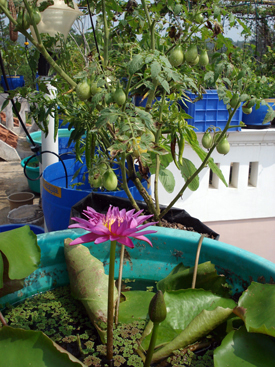
Water lilies attract bees and dragonflies that help fertilize Sujitha’s tomatoes and chilies. (Photo: Helen Palmer)
PALMER: And that looks like a grape vine growing over the trellis on the top here?
SUDHAKARAN: Yes, yes, it’s a grape-vine, I planted it one year back and I’m expecting fruits this year. Because the grapes that we get here is almost full of pesticides. They spray a lot of pesticides in order to get the fruits, so I thought OK at least one bunch I can eat without pesticide.
[SUJITHA LAUGHS]
PALMER: Pesticides. That’s the problem Sujitha and thousands of other concerned Keralans are trying to solve by going organic. Both doctors and the public believe chemicals lurking in food share a large part of the blame for high levels of cancer in Kerala, and that’s led the state government to call for a totally organic agricultural sector by 2020. One group of Keralans in particular has taken up gardening without pesticides or chemical fertilizers with special zeal -- educated professionals. Take this retired bank executive – who lives on a busy street behind a sturdy metal gate in a fashionable Trivandrum suburb.
[SOUNDS OF TRAFFIC, GATE CLANGING, AND WORKMEN BANGING]
KRISHNAN: I’m Unni Krishnan. I was designated the agriculture officer, financing farmers and agriculturalists, and that was a turning point in mid-life.
PALMER: Unni Krishnan is tall, earnest and white haired. That turning point working with farmers made him retire from his safe, comfortable job at the State Bank of Travancore 12 years early to grow his own food, and to teach other people how to do the same. He says he’s inspired hundreds….
KRISHNAN: Around 400, to 500 people I have inspired, you know.
PALMER: Really?
KRISHNAN: Yes sure, through Facebook also, people get inspired.
PALMER: In the large garden he has behind the gate, neat rows of dozens of pots of chiles, okra, eggplant, amaranth and cabbages spill over from the garden to the patio. On his three roof terraces, gourds and tomatoes hang from the tall shade trellis he built with hemp rope and bamboo. On a wall, scarlet chili peppers sit on a plate drying in the sun. Unni says he has to water his many pots and bags twice a day and it takes hours, but that’s OK, it’s his passion.

Unni Krishnan (right) and wife Latha (left) have three large roof terraces. Unni used to work at the state Bank of Travancore, but retired early to grow his own organic food and inspire other Keralans to do the same. (Photo: Helen Palmer)
KRISHNAN: My work is my hobby, it’s a kind of meditation for me. I don’t identify outside world when I do this work.
PALMER: His garden is a calm oasis on a busy street, with high brick walls surrounded by tall coconut palms. He shows me the potting mix he prepares and hands out with grow bags.
KRISHNAN: This is potting mix I give. Potting mix, it is a combination of soil, then peat, then organic fertilizer also.
PALMER: How is the soil in Kerala?
KRISHNAN: Actually it’s a bit acidic in Kerala, so probably you can use that lime to make it alkaline.
PALMER: The poor soil he points to is not a problem for home gardeners like Unni Krishnan who takes feeding the soil very seriously and can easily afford that lime. At her home, Sujitha Sudhakaran has her own whole complex system set up outside her kitchen, where workmen are installing a new cupboard for her.
SUDHAKARAN: For my plants which are on the top, I make compost. I make vermicompost and I make bokashi composting.
PALMER: So Bokashi is what? It’s not a word I know.
SUDHAKARAN: Actually it’s a Japanese word which means ‘ferment, to ferment’, and it’s a technology wherein we add micronutrients directly to the compost so that the decaying process fastens. So I get almost all the compost which is required for my plants from my home, so I don’t buy it from outside.
PALMER: She points to her dozens of buckets – old industrial containers salvaged from the scrap heap.
SUDHAKARAN: This is mainly my composting area.
PALMER: Oh I see you’ve got many many big containers, these are all full of compost?
SUDHAKARAN. Compost – one will be full of cow dung, one will be with another type of compost, one will be with coffee grounds and egg shells, and this one is like rice water, starch which I use as a pesticide, this is a biogas plant…
[WORKMEN BANGING]
… wherein I can put all the waste into it and the biogas slurry will be collected at the other end, which I can use as a fertilizer for my plants.
PALMER: So they collect the biogas and use the biogas, and what’s left you can use as fertilizer?
SUDHAKARAN: Yes, the gas I can use for cooking and the slurry, the left over, that I can use for my plants.
PALMER: Gosh, so what goes into the biogas plant?
SUDHAKARAN: All the waste, I mean kitchen waste, we can put fish waste, chicken waste, not the bones, but the other meat part, we can put in there, left over rice we can put in there – except lemon we cannot put that – onion peels, we cannot put that also, so all the other things, it goes into that.
PALMER: Wow! And it generates biogas for you?
SUDHAKARAN: Yes for cooking, and at the same time the slurry is collected.
PALMER: That’s extraordinary that somebody does that on a home level.
SUDHAKARAN: [LAUGHS] Yeah.

Sujitha built her own hydroponic system on her roof terrace, and uses the fish waste as fertilizer. (Photo: Helen Palmer)
[SOUNDS OF CLIMBING STAIRS, OUTSIDE SOUNDS, DISTANT TRAFFIC]
PALMER: And Sujitha is extraordinary – we climb up to her roof terrace where she keeps an aquaponic system and grows rice….
SUDHAKARAN: There are fishes inside this – this tank…
PALMER: Oh I see! what kind of fishes? They look like goldfish.
SUDHAKARAN: This is spotted fish, and there is another one, tilapia. I harvested, I planted a paddy, but I harvested and now it’s not there, this is a second crop –this is a kind of spinach, these are chili plants, I pruned it, and these are cow peas.
PALMER: I’m astonished by how much she can grow in her bags and pots – they’re just pots, they’re not garden beds. Sujitha’s husband, Manu, tells me she grew enough food for a feast for their whole extended family at India’s Thanksgiving, the late summer harvest festival Onam.
MANU: Last Onam, we decided to call all our family here and we all joined and we made food out of what we’d grown from our terrace, so completely it was from our terrace.
PALMER: So what did you actually eat?
MANU: We made – we call it sadya – we’ll have boiled rice, there would be something called avil, which is made out of 4 different vegetables, we use a lot of vegetables, and then there would be a curry that is called a sambah, which is made out of, again vegetables, so it would be a complete vegetarian feast. So including the rice, everything required for that was grown here, in our terrace!
PALMER: The bounty of food from organic home gardeners like Sujitha has helped launch another Kerala innovation – organic markets.
[BUSY TRAFFIC]
On Saturdays, small farmers and rooftop cultivators bring their spare produce to the Centenary Indoor Stadium. It’s a large shed in the heart of Kerala’s cultural capital, Thrissur, about 180 miles north of Trivandrum.
[NOISY TRAFFIC, ECHOEY MARKET SOUNDS, CHATTER]
Outside the stadium, incessant traffic circles a large park where a solemn elephant tethered under large trees munches on palm fronds; inside, trestle tables are piled high with bananas and squash, spinach, tamarind, bottles of coconut oil, yams, papaya and spiky young jack fruit. The place is packed, and I’m instantly cornered by a large man.
JOSEPH: My name is not that difficult, it’s Paul Joseph.
PALMER: He tells me he’s at the market as a buyer and a seller.
JOSEPH: I have an orchard where I have most of the things, like most of the vegetables and fruits. I have different varieties of papaya, the Red Lady and one variety from US also I have – and I do have a lot of naranjas, you know, citrus fruits.
PALMER: Aha – so oranges?
JOSEPH: Not oranges, oranges are not grown in this part, limes, different types of limes.
PALMER: Limes? Okay.
JOSEPH: And leafy vegetables, plenty leafy vegetables.
PALMER: Paul Joseph retired after 28 years as a chief engineer in the merchant marine, and he’s an enthusiastic guide to the market, identifying unfamiliar looking vegetables.
PALMER: What is that?
JOSEPH: Spinach, that’s a different kind of spinach.
PALMER: Aha – what are those things beside it?
JOSEPH: That one is – you know the banana tree?
PALMER: Yeah.
JOSEPH: It’s the stem of the banana tree.
PALMER: The stem of the banana tree?
JOSEPH: They say that it’s very good for diabetes and all those things. And the next one is noni.
PALMER: Noni?
JOSEPH: It’s an anti-oxidant, they say that it’s very good for cancer, it’s a Brazilian fruit.
PALMER: It’s a fruit?
JOSEPH: It’s a fruit. The next one is a yam. –
PALMER: A yam, OK.
JOSEPH: There are 2 different interesting things – this is the urine of the cow – it’s used in two ways. One, this is used as pesticide, and also as medicine.
PALMER: As medicine?
JOSEPH: Yeah.
PALMER: People take it? People drink it?–
JOSEPH: How do they use it I have no idea.
SANOJ: It is a general health tonic –
PALMER: Say again?
SANOJ: General health tonic.
PALMER: People drink it?
SANOJ: Yes, drink it – do you want to taste it? Want to taste it? –
PALMER: NO! [LAUGHS]

Sheba made a popular snack of rice flour and coconut sugar, steamed in a banana leaf, that’s known as Adha. (Photo: Helen Palmer)
PALMER: Cows, of course, are sacred in Hindu India, and though about 20% of Kerala’s population are Catholics like Paul Joseph, cow manure and urine are still put to many uses.
There are good things to eat at the market too – as well as selling spinach and curry leaf, Sheba, a home maker in a brilliant fuschia headscarf, has prepared adha, a popular sweet snack of rice flour, grated coconut and jaggery, raw coconut sugar wrapped in a banana leaf.
SHEBA: This making rice powder and including certain sweets.
PALMER: And you cook it in a banana leaf?
SHEBA: Banana leaf.
PALMER: And you boil it?
SHEBA. Steaming, steam.
PALMER: Steam…
SHEBA: Yes.
PALMER: – It’s very sweet, but actually quite delicious. Among the farmers are retired doctors, and university professors, and business people. Another home maker, Seena Mohan, dressed in a stylish sari and married to the owner of two movie theaters, is there buying organic tomato seedlings with her daughter Sapna, an eye doctor who explains her mother’s plans.
SAPNA MOHAN: We have an empty space – so she likes to do a bit of farming, actually for vegetables which are pure - even she’s planning to buy a cow!
PALMER: Really? What do you think about this?
SAPNA MOHAN: I don’t know, I have no time to look after, she is more interested, so let her try.
PALMER: Why do you want to do this?
SEENA MOHAN. Because we are hearing about this poison and everything in our foods – even we are importing these foods from other countries – I am starting cultivating fruits and vegetables, different type, just starting.
PALMER: So tomatoes – what else will you grow?
SEENA MOHAN: Tapioca, yeah, tapioca, then tomato, the chili, then coconuts, then banana, lot of fruits, mangosteen, rambutan, different types of mangos, different types of Jack fruits - I planted, I think I planted 60 numbers of fruits trees plants.

The snake gourd is a popular Keralan vegetable, even among children. (Photo: Helen Palmer)
PALMER: I’m struck by the easy relationships in the market – growers and customers like Seena, who’s Hindu, Sheba, a Muslim, and Paul Joseph, who is Catholic, are united by their common passion for growing and spreading the gospel of healthy organic food. I meet one of the market organizers, Sandhya Kumar, who’s infectiously cheerful and energetic – and like so many, has taken on a second career as an organic gardener.
KUMAR: Last 24 years I was working as a teacher in our area schools, then became passionate towards agriculture, I resigned the job, and I’m doing agriculture now, last 2 years, I started agriculture – and I’m fully organic.
PALMER: On her fully organic acre of land, Sandhya grows the now familiar staples -- coconuts, bananas, eggplants, nutmeg, pepper -- but she also has hens, goats, a cow and a down-to-earth, very business-like approach.
KUMAR: So with that cow I am making ghee and paneer also, as value added products.
PALMER: So ghee is clarified butter, I know and paneer is cheese.
KUMAR: Hmm, with the hibiscus flower I will make squash, like that.
PALMER: So you make hibiscus flower squash?
KUMAR: [LAUGHS] Then brinjal – I will make pickles.
PALMER: Ah – pickled eggplant.
KUMAR: And virgin coconut oil also I am making, with our own coconut, with that I am making virgin coconut oil. Plenty of people are waiting for these organic products so no problem at all selling. [LAUGHS]
PALMER: That is very good!
KUMAR: Milk also I am selling!
PALMER: The milk from the cow?
KUMAR: Goat, goat milk also.
PALMER: Goat?
KUMAR: 100 rupees per liter the milk – normally here, one liter ordinary cow’s milk will cost 40 rupees, now goat milk costs 100 Rupees, that’s the difference.
[TRAFFIC SOUNDS FADE, BIRDS AND GARDEN SOUNDS]
PALMER: Sandhya invites me to her farm – she lives in a large cool house shaded by coconut palms and jack fruit trees at the end of a long drive.

Sandhya’s acre of land is also home to hens, goats, and a cow as well as her organic garden. (Photo: Helen Palmer)
[DOG BARKS]
KUMAR: My husband.
PALMER: Pleased to meet you.
AJIT KUMAR: Hello.
KUMAR: So this is our home.
PALMER: And your name is, Sir…?
AJIT KUMAR: Ajit.
PALMER: Ajit?
KUMAR: Don’t ask anything about agriculture, organic, he will not know anything about that!
PALMER: He is a businessman you say.
[SANDHYA LAUGHS]
PALMER: Business man. But you support your wife?
AJIT KUMAR: Supporting. Fund is mine, all funding is mine!
[AJIT AND SANDYA BOTH LAUGH]
PALMER: Ajit runs a successful chain of coffee shops that employ people with disabilities.
[BIRDS, WALKING THROUGH DRY LEAVES]
Sujitha leads the way out to the wide green garden behind the house. There are coconut palms, bread fruit, dozens of banana and mango trees and in their shade, she plants spices.
KUMAR: This year I planted the ginger.
PALMER: That is ginger?
KUMAR: Ah, it’s ginger. Ginger last year in our market, 10 Kgs, I sold out, 100 Rupees per Kg.
PALMER: 100 Rupees per kilogram?
KUMAR: Non-organic, 60 Rupees per kilogram –
PALMER: But organic 100.
[GOATS BLEATING, WALKING THROUGH DRY LEAVES, BIRDS]
PALMER: We thread our way through her lush jungle of fruit trees and spice bushes, their roots kept cool by palm fronds and dead leaves as mulch. We pass the goat pen -
[GOATS BLEATING]
- and reach the bank of a small irrigation ditch where her dark brown cow is grazing. Her name is Muta, which means Pearl. Around her banana trees Sandhya has spread the goats’ droppings – and she says the cow and her calf give useful products beyond milk. We walk to her cowshed – basically just a roof of interlaced palm fronds over a concrete floor that slopes down to a shallow tank in one corner.
KUMAR: In this tank we will collect urine. These 2 buckets, every weekly once, I made that organic manure with the cow dung, cow urine, then jaggery, then soil.
PALMER: Jaggery is concentrated raw sugar made from coconut palms. Sandhya says that manure not only fertilizes her plants but has transformed her soil since she started her organic garden two years ago.
KUMAR: Every year I can feel the change in this soil. Just two years before, I felt this soil as dead. Now I can feel it just smart like me, the soil!
[SANDYA LAUGHS]
PALMER: It’s full of earthworms and leaf mold now, she says. As we head back to her house, Sandhya confides….

Sandhya refers to her husband Ajit (above) as “elephant lazy,” since he likes to sit and watch TV. But he pays for whatever she wants for her organic farm. (Photo: Helen Palmer)
KUMAR: My husband is elephant lazy – like that way I call you understand what’s that? Very lazy, that much lazy. 24 hours he will sit like this, watching TV or doing something. Then whatever I ask, he will give – money – no inquiry, no interventions, nothing.
PALMER: It sounds like a perfect marriage!
[SANDYA LAUGHS]
PALMER: Sandhya and Ajit and the investment of labor and cash they’re prepared to make are typical of Kerala’s middle-class backyard and rooftop gardeners. And they’re part of the state government’s calculation for how it can reach its ambitious Green Kerala goals – 100% organic food by 2020 -- at least as far as vegetables are concerned.
For Living on Earth, I’m Helen Palmer in Kerala, India.
Related link:
The Government of Kerala, India
[MUSIC: BeatbyShahed, https://youtube.com/c/djshahmoneybeatz https://facebook.com/beatbyshahed https://soundcloud.com/djshahmoneybeatz https://instagram.com/imshahed, “INDIAN RIDDIM *ORIGINAL* Bollywood/Dance/Hip hop/Pop instrumental”]
CURWOOD: Living on Earth is produced by the World Media Foundation. Our crew includes Naomi Arenberg, Bobby Bascomb, Thurston Briscoe, Jenni Doering, Jaime Kaiser, Don Lyman, Lizz Malloy, Aynsley O’Neill, Jake Rego, Adelaide Chen, and Jolanda Omari. Tom Tiger engineered our show. Alison Lirish Dean composed our themes. You can hear us anytime at L-O-E dot org, iTunes and Google play- and like us, please, on our Facebook page - PRI’s Living on Earth. We tweet from @livingonearth. And see us on Instagram @livingonearthradio. I’m Steve Curwood. Happy New Year!
ANNOUNCER: Funding for Living on Earth comes from you, our listeners, and from the University of Massachusetts, Boston, in association with its School for the Environment, developing the next generation of environmental leaders. And from the Grantham Foundation for the protection of the environment, supporting strategic communications and collaboration in solving the world’s most pressing environmental problems. Support also comes from the Energy Foundation, serving the public interest by helping to build a strong, clean, energy economy and from Carl and Judy Ferenbach of Boston, Massachusetts.
ANNOUNCER 2: PRI, Public Radio International.
Living on Earth wants to hear from you!
Living on Earth
62 Calef Highway, Suite 212
Lee, NH 03861
Telephone: 617-287-4121
E-mail: comments@loe.org
Newsletter [Click here]
Donate to Living on Earth!
Living on Earth is an independent media program and relies entirely on contributions from listeners and institutions supporting public service. Please donate now to preserve an independent environmental voice.
NewsletterLiving on Earth offers a weekly delivery of the show's rundown to your mailbox. Sign up for our newsletter today!
 Sailors For The Sea: Be the change you want to sea.
Sailors For The Sea: Be the change you want to sea.
 The Grantham Foundation for the Protection of the Environment: Committed to protecting and improving the health of the global environment.
The Grantham Foundation for the Protection of the Environment: Committed to protecting and improving the health of the global environment.
 Contribute to Living on Earth and receive, as our gift to you, an archival print of one of Mark Seth Lender's extraordinary wildlife photographs. Follow the link to see Mark's current collection of photographs.
Contribute to Living on Earth and receive, as our gift to you, an archival print of one of Mark Seth Lender's extraordinary wildlife photographs. Follow the link to see Mark's current collection of photographs.
 Buy a signed copy of Mark Seth Lender's book Smeagull the Seagull & support Living on Earth
Buy a signed copy of Mark Seth Lender's book Smeagull the Seagull & support Living on Earth

